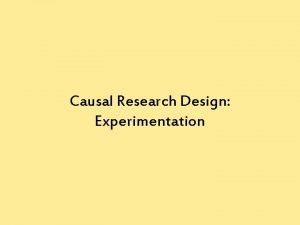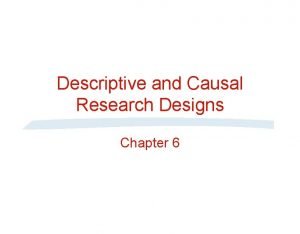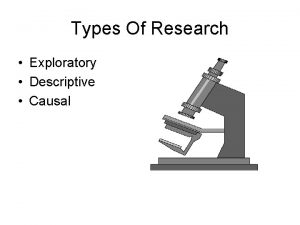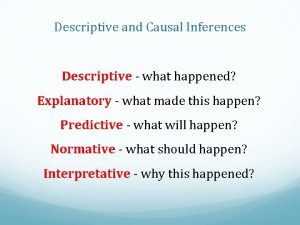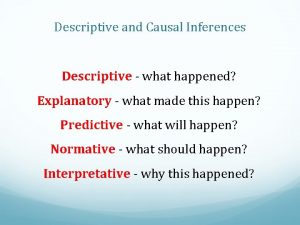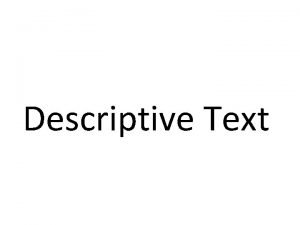Descriptive and Causal Research Designs Chapter 6 Classification










- Slides: 10

Descriptive and Causal Research Designs Chapter 6

Classification of Descriptive Studies Continuous Panel Longitudinal Discontinuous Panel Descriptive Studies Cross Sectional Sample Survey SLIDE 6 -1

Longitudinal vs. Cross-Sectional Data LONGITUDINAL DATA • allows turnover analysis if panel is continuous • allows collection of much more classification information from respondents • allows longer and more exacting interviews • produces fewer errors in reporting past behavior because of natural forgetting CROSS-SECTIONAL DATA • tends to produce more representative samples of the population of interest • produces fewer errors due to respondent’s behavior being affected by the measurement task • allows the investigation of many more relationships • produces fewer interviewer— respondent interaction errors SLIDE 6 -2

Brand Switching Example: Number of Families in Panel Purchasing Each Brand Purchased During First During Second Time Period t 1 Time Period t 2 A 230 280 B 310 290 C 340 310 D 120 1, 000 Total SLIDE 6 -3

Brand Switching Example: Number of Families Purchasing Each Brand in Each Period During Second Time Period t 2 Bought A During First Time Period t 1 Bought B Bought C Bought D Total Bought A 210 20 0 0 230 Bought B 0 260 50 0 310 Bought C 0 0 260 80 340 Bought D 70 10 0 40 120 280 290 310 120 1, 000 Total SLIDE 6 -4

Brand Switching Example: Proportion of Families Purchasing Each Brand in Each Period During Second Time Period t 2 Bought A During First Time Period t 1 Bought B Bought C Bought D Total Bought A . 913 . 087 . 000 1. 000 Bought B . 000 . 839 . 161 . 000 1. 000 Bought C . 000 . 785 . 235 1. 000 Bought D . 583 . 000 . 333 1. 000 SLIDE 6 -5

Types of Evidence That Supports a Causal Inference • Concomitant variation—evidence of the extent to which X and Y occur together or vary together in the way predicted by the hypothesis • Time order of occurrence of variables—evidence that shows X occurs before Y • Elimination of other possible causal factors— evidence that allows the elimination of factors other than X as the cause of Y X—the presumed cause (independent variable) Y—the presumed effect (dependent variable) SLIDE 6 -6

Types of Experiments Laboratory Experiment Scientific investigation in which an investigator manipulates and controls one or more independent variables and observes the degree to which the dependent variable or variables change Research investigation in which Investigator creates a situation with exact conditions so as to control some, and manipulate other, variables Field Experiment Research study in a realistic situation in which one or more independent variables are manipulated by the experimenter Under as carefully controlled conditions as the situation will permit SLIDE 6 -7

Relationship Among Types of Test Markets Simulated Test Market Not Promising Abort Controlled Test Market Not Promising Standard Test Market Abort Not Promising Abort Promising National Rollout SLIDE 6 -8

Relative Advantages and Disadvantages of Different Types of Test Markets simulated controlled standard Speed 1 2 3 Cost 1 2 3 Security 1 2 3 * internal 1 2 3 * external 3 2 1 Validity Prediction accuracy 1 = most favorable 2 = least favorable SLIDE 6 -9
 Casual research example
Casual research example Exploratory, descriptive and causal research
Exploratory, descriptive and causal research Conclusive research advantages and disadvantages
Conclusive research advantages and disadvantages Exploratory research design types
Exploratory research design types Exploratory, descriptive and causal research
Exploratory, descriptive and causal research Causal comparative research vs correlational
Causal comparative research vs correlational Qualitative paper example
Qualitative paper example Chapter 10 qualitative research designs
Chapter 10 qualitative research designs Chapter 10 qualitative data analysis
Chapter 10 qualitative data analysis Exploratory descriptive causal
Exploratory descriptive causal Solomon four group design
Solomon four group design
